How to grow a lemon tree at home, care basics
Evergreen citrus crops harmoniously fit into the interior of apartments and offices. Growing lemon attracts indoor flower lovers with its exoticism, combined with the ease of caring for the tree. Many have tried to plant a bone extracted from a sour fruit in a pot, but not everyone managed to achieve the desired result. In order for the plant at home to please with luxurious flowering, and fruits ripen on its branches, you will have to try. And the first step here is a careful study of the cultural requirements for conditions of detention.
Lighting and temperature
The subtropical origin of lemon makes it capricious in terms of temperature. The plant loves heat, but does not tolerate extreme heat, especially if the air is dry. At home, he will be most comfortable in a room where the air is warmed up to + 10- + 22 ° C. Providing a moderate temperature to a lemon tree in an apartment in summer is not easy. Many gardeners find a way out by placing a pot with a plant on the loggia. Owners of a private house can take it outside and leave it under a canopy until autumn. In winter, in the room where the indoor lemon grows, the temperature should not exceed + 14 ° C. But it is also impossible to allow it to fall below + 10 ° C.
All citrus fruits love light. But compared to its relatives, the lemon tree tolerates a lack of sunlight less painfully. You can even grow it at home on the northern windows, although it is better to choose the southeast side for the pot. An adult lemon is not afraid of direct sunlight. It can also be placed on a south-facing windowsill. If the plant is young, it will need shading care. The delicate leaves of the tree can suffer from sunburn.
In winter, when it gets dark early, indoor lemon needs additional lighting. It is organized using special phytolamps. Certain types of culture can easily tolerate short daylight hours and are able to do without additional care. These include the undersized Panderoza variety. If you add coolness (from +7 to + 14 ° C) to a short daylight hours, the plant will plunge into a dormant period. A hibernating lemon tree is rarely watered. You don't need to light it up.
Soil and pot
To plant a plant correctly, you need to take into account the characteristics of its root system. The citrus genus has no root hairs. Soil mushrooms help lemon to absorb water and nutrients from the soil. They can be seen on its delicate roots. They look like strands forming bulges at their ends. The roots of the tree and mushrooms interact closely with each other. In the scientific literature, their symbiosis is called mycorrhiza. She is very sensitive to external conditions and can die in an unfavorable environment:
- prolonged drought;
- lack of air;
- a sharp drop in temperature (below -7 ° C);
- extreme heat (if the thermometer rises above + 50 ° C).
From this follow the basic rules for growing lemon:
- do not allow the substrate to dry out in the pot;
- do not flood the tree.
The plant grows well in loose soil rich in nutrients. Its reaction should be neutral (with a pH in the range of 5.8-6.5). The easiest way is to purchase ready-made soil for citrus fruits in the store.
To prepare a nutritious substrate at home on your own, three components are mixed:
- sod land (3 parts);
- humus earth (1 part);
- sand (1 part).
Advice
If you need to plant an adult lemon, the volume of humus in the earth is doubled.
You can also fill the pot with a composition of sod land, deciduous soil and dung.
All components are taken in equal proportions. River sand will give the resulting substrate looseness, and crushed charcoal will enrich it with minerals.
For planting lemon at home, it is best to use a clay pot. If the plant is large, it will thrive in a wooden tub. Natural materials will facilitate the penetration of air to the roots of the tree. At the bottom of the planting tank, drainage is poured with a layer of 2 cm.You can make it from broken brick. From above, the drainage layer is covered with sand, and then the pot is filled with a nutrient substrate.
Reproduction methods
Indoor lemon can be grown from seed, cuttings, or cuttings.
The easiest way to propagate a tree that is already bearing fruit is at home by cutting cuttings from it. Young lemon branches with not yet hardened and flexible wood are suitable for their harvesting. They must be one year old or slightly older.
A correct stalk has the following characteristics:
- length not less than 10 cm;
- 3-4 developed kidneys;
- at least 3 sheets.
The cut line from above should be at right angles and 7 mm from the kidney. 1 cm recede from the lower kidney. The cut is made at an angle of 45 °. From above the wound is smeared with garden pitch. It will protect the cutting from infection. It is desirable to apply shallow grooves to the lower cut with a needle. This will improve root formation. You can plant cuttings at home in sand or in a nutritious substrate. Having made a small indentation, put a cut branch in it. You do not need to press it into the soil.
Advice
Before planting, the lower part of the cutting is dipped into a solution of a drug that stimulates root growth, where it is kept for 1-2 hours.
Cuttings will take root faster if the leaves on them are cut with scissors by ⅔. This way they will evaporate less moisture. The planted stalk is covered with a jar. Lemon roots form slowly. In a warm place (at a temperature of + 25 ° C) and with a constant humidity of the substrate, they will have to wait 2-3 months.
Cutting care is simple. They need to provide a lot of light, but the direct rays of the sun should not fall on them. With the appearance of the first leaves, the process of adaptation of the cuttings to the air of the room begins. Raise the jar and put a chip or other support under it so that a small gap is formed. The size of the hole is gradually increased. You can do it differently - air the future tree daily. First, the jar is removed from the handle for a couple of minutes, the next day this time is doubled. It will take 2 weeks of airing for the sprout to get used to the climate at home. Then the shelter can not be returned to its place.
Professionals almost never use the generative way of breeding lemon. It is not difficult to plant a seed in a pot, but the plant obtained from it is unlikely to bear fruit, even if it is provided with proper care. There is only one way out - to plant a tree. It will take 2-3 years, and fruit can be picked from its branches. For grafting, cuttings from a fruiting plant are most often used. A good result is given by budding with an eye.
Watering
Lemon prefers moderate watering. The soil in the pot is moistened with water at room temperature, which is pre-defended. You can add a little vinegar to it (2-3 drops per 1 liter). The liquid accumulated in the pan is drained, not allowing it to remain in it for more than 2-3 minutes. In the summer, at home, the procedure is carried out every day or every other day. The condition of the soil will help to determine when the next watering is needed: if the earthy lump has dried out, it's time to moisten it.
Lemon responds well to spraying treatments. They are carried out daily, regardless of the season. Spraying is especially important for wood in winter, when the air becomes dry due to the operation of heating devices. But you cannot overdo it with them, otherwise the plant can be affected by fungal diseases.Spray the leaves with warm water, occasionally you can do this with a weak solution of potassium permanganate to strengthen the health of the plant. With the onset of cold weather, watering is reduced, but not much - up to 2 times a week.
Problems when growing citrus at home are most often due to irregular or too much moisture. When underfilled, the leaves on the tree turn yellow, wither, and mycorrhiza dies. Excessive moisture will lead to acidification of the soil in the pot and rotting of the plant roots. It is important to carry out the procedure correctly by distributing water over the surface of the substrate. If you pour it into one place, the earthy ball will get wet unevenly, and the roots may suffer from leaching.
At home, lemon is periodically "bathed". Such care is carried out once a month. The soil is reliably protected with a film, and a warm shower is arranged for the leaves of the tree, thoroughly rinsing them from all sides. This is necessary to clean their surface from dust and other contaminants. When they accumulate on leaves, they interfere with photosynthesis, which weakens the plant and can cause health problems.
Top dressing
In order for the lemon to grow quickly at home and not lose its decorative effect, it will need regular feeding. It will not work to do with one drug. Fertilizers should be different and should be changed periodically. If you use the same nutrient for a long time, the reaction of the soil will change. It will become too acidic for lemon or alkaline. From such soil, the plant will not be able to receive the elements necessary for its development.
At home, they begin to feed lemon in March. Until October, it is fed once every 2-3 weeks with either organic or mineral compositions. If the plant is young, fertilize it less often - once every 1.5 months. In the summer, fertilizing is combined with watering. In spring and autumn, fertilizers are applied to an already moistened soil. At least 2 hours should pass from the moment of watering. Lemon suffers from an excess of nutrients in the soil even more than from a lack of them. Therefore, you cannot overfeed him.
From the middle of autumn, fertilization begins less often. A plant that has fallen into hibernation ceases to need feeding. If it hibernates in warmth and with good lighting, they are carried out every 1.5 months. Complex mineral compositions are suitable for lemon. Of organic fertilizers, it reacts well only to some types:
- wood ash extractor;
- infusion of birch leaves or quinoa (filling the jar with chopped green mass by ½, add water; 2-3 days, and the natural fertilizer will be ready);
- weak (diluted 5-6 times) infusion of fresh manure.
Advice
If the leaves are actively growing on the lemon, and flowering is delayed, it is worth changing the fertilizer. Nitrogen-rich formulations are eliminated by feeding citrus with preparations high in phosphorus.
Pruning
You cannot do without crown formation when caring for lemon at home. Regular pruning has a decorative and sanitary function. Its scheme is determined by the purpose of growing the tree. Decorative lemons do not need a large crown, they give it a compact shape. In fruiting citrus, the main branches must be balanced by the growing shoots. Crown formation is carried out by pinching. First, a skeleton of a tree is created, cutting off the side branches so that they do not outweigh each other and do not interfere with the development of neighboring ones.
When the lemon is 1 year old, the main shoot is shortened to 30 cm. Then the buds located on its sides will sprout, forming lateral branches. When they develop well, they are pinched, leaving 3-4 leaves on the shoot. Such care is necessary for the lemon, otherwise its branches will grow very long and bring a meager harvest, which will take a long time to wait. The tree is allowed to bear fruit after its crown is formed. If it blooms earlier, the buds are cut off. Otherwise, the plant will greatly weaken and may even die.
Old branches that interfere with the development of the lemon and will dry out sooner or later should be pruned so that they do not draw strength from the tree.They also remove weak, growing inside the crown or interfering with neighboring shoots. Pruning is usually done in March, but it can also be done after harvest. For a fruiting lemon, care is required in the form of removing excess buds. The plant blooms profusely, but the ovaries are normalized by the number of leaves. For each fruit, there must be at least 10 of them, otherwise the depleted lemon will not please the next harvest soon.
During the ripening of the fruit, the tree requires increased attention. They handle it very carefully, trying to completely eliminate factors that can lead to shedding of the ovaries:
- lack of nutrients;
- drafts;
- dry air;
- lack of light;
- disease.
Transfer
Novice growers often make a mistake that negates all their efforts to grow a lemon tree at home. It consists in trying to plant young citrus in a large pot at once. As a result, the growth of the tree is greatly slowed down, its roots rot, and the lemon dies. The planting capacity should be commensurate with the plant's root system. When it develops and fills the entire pot, the lemon is transferred to another container, the volume of which is slightly larger. It is better to do this in spring, when the tree begins a period of active growth.
The bottom of the container is covered with a drainage layer. On top of it, put a lemon extracted from an old pot along with an earthen lump. The cavities on the sides are filled with fresh substrate, prepared at home or purchased from the store. The plant is watered abundantly. After moistening, the soil will settle, then more earth is added. Lemon roots must "breathe". If the pot is firmly on a pallet, it is advisable to place small stones or chips between them to improve air circulation.
The transplanted tree is returned strictly to its original place, without changing its orientation. Lemon reacts sensitively even to minor turns, responding to them with stress and loss of decorativeness. The leaves of the tree follow the sun. To prevent its crown from being one-sided, you need to slightly rotate the pot around its axis. This is done every 10 days, very carefully, deviating from the previous position by a maximum of 10 °.
Lemon will take pride of place among the plants on the windowsill. But in order for it to become a real decoration of the room and a source of pride, you will have to pay attention to it. Taking care of the lemon tree is easy. His agricultural technique consists of procedures familiar to all lovers of indoor flowers. Only they must be carried out strictly in accordance with the requirements of the plant, because the lemon will not tolerate neglect. If you provide the tree with comfortable conditions, it will please the eye all year round, either with its glossy leaves, or with an abundance of unusual flowers, or with bright shades of ripening fruits.
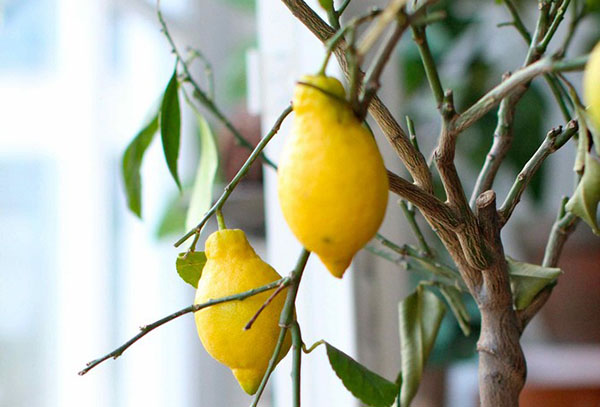
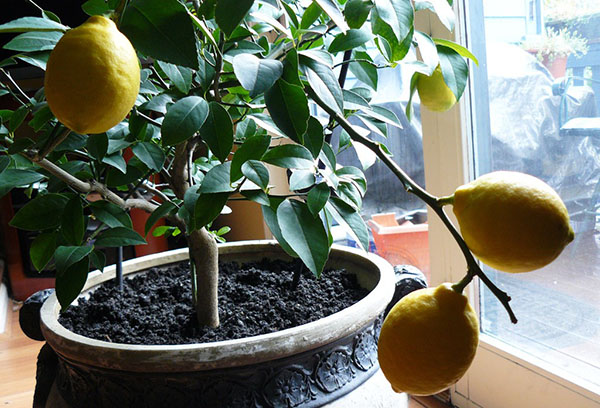
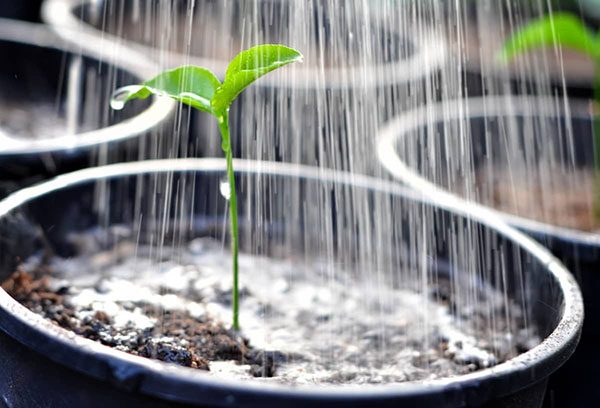
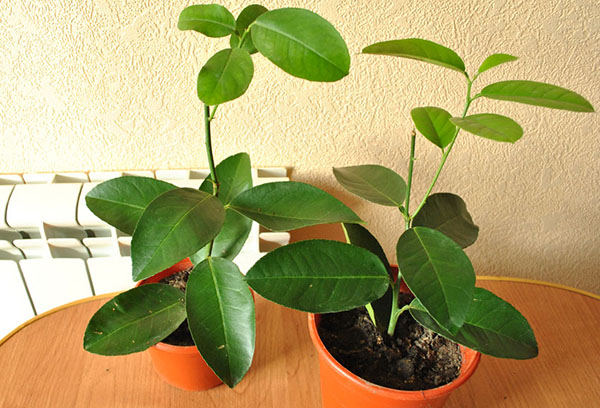
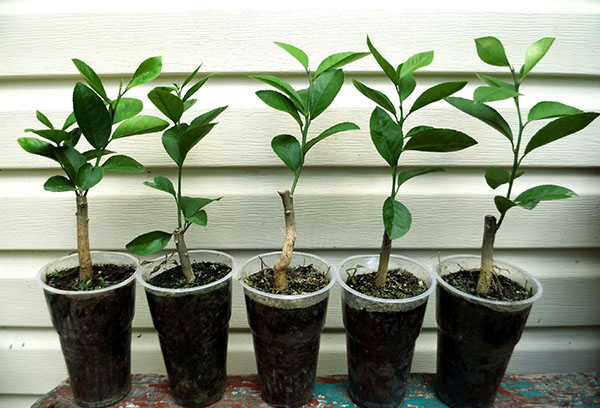
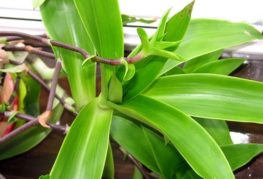

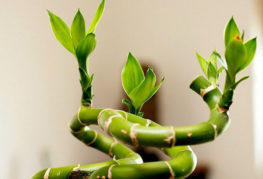



and will be published shortly.